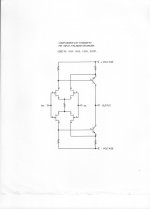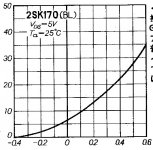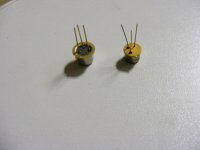"Никогда не разговаривайте с неизвестными" Михаи́л Булга́ков
Wavebourn is there any more to the translation ?
.
No more, it is just the title of 1'st paragraph of his Master And Margarita, where Devil meets corrupted heroes... But how it is related to the topic?
better subcircuit to talk about
Load resistor values are fairly low, so cascoding of the input FET's isn't needed as much as might otherwise be. Power limits near Idss and 24VDC?
Thanks,
Chris
No more, it is just the title of 1'st paragraph of his Master And Margarita, where Devil meets corrupted heroes... But how it is related to the topic?
It was only as a response to the Diamanda Galas quote (Mr Wurcer currently uses).
The book I have translates it to "Never Speak to Strangers". Google translates it to "Never talk with the unknown".
.
This one doesn't show gate current but it shows where that Idss + 20mA peak comes from.Trick question? We need one more graph, to see how much Vgs we can get away with before gate current becomes a problem.
EDIT - this picture is not mine. It was posted by someone fluent in Japanese on this same thread several hundred(?) pages back. Positive Vgs is also discussed in "Designing with field effect transistors" by Arthur D.Evans 1981; p.116
Attachments
Last edited:
Remember, everyone, these are SUBCIRCUITS, NOT complete, whole designs which would just confuse the discussion. Every one of these SUBCIRCUITS can have a cascode added, both on the first stage and the second stage, and usually do. However, I have to get everyone up to comprehending the CORE of the design, before we can expand. Many here sound like a lot of college 'sophomores'. '-)
It was only as a response to the Diamanda Galas quote (Mr Wurcer currently uses).
The book I have translates it to "Never Speak to Strangers". Google translates it to "Never talk with the unknown".
.
First names please.
Thanks Elecktroj, normally we operate below Idss, BUT we do not run out of current in this circuit, just because we go past 2Id, or even at Idss. This is only useful for transients, but it potentially speeds up the circuit considerably.
John I'm not a FET specialist but I don't see what's significant here? Can't you just increase Vgs untill you get the peak current you want (within the reliability limits of course)?
What's the issue here?
jan
G-S must not become forward conductive.
It's just fine for a few hundred millivolts, right ? (Just don't forward bias the junction.)
.
J.C.
I have been mentioning a few things about FET production that I though was a bit weird.
FETs are very useful in high impedance low noise circuits. They are perform quite closely to vacuum tubes but with lower noise. They also are very resistant to EMP issues.
Yet even though they have many advantages, production of silicon FETs seems to be virtually zero. (Yes there are a few folks left, but even germanium semiconductors appear to be produced in greater volume!)
More interesting is that Siliconix was selling significant product to the military, but they stopped buying when they found out the product was no longer made in the U.S.
Now did they stop needing the devices? Probably not.
There is the "Trusted Foundry" program to produce devices for the military users that is restricted in many ways.
IBM and Western Electric were the two first folks to offer such devices for the military and the NSA! When the Allentown Western Electric Foundry opened it was announced it's production was primarily for the military.
Now the Western Electric plant closed in 2002.
I recently was cleaning out the lifetime collection of junk from a closed facility.
Guess what I found... an amazing collection of Allentown Western Electric transistors.
Some were germanium with date of manufacture quite recent. Some standard silicon and even some RF parts in unique packages. Many were marked.
But what was really interesting there were a fair number of FETs! The picture shows one of them it is in the larger can. That is a TO-8 size next to the common TO-5.
These devices came in paper envelopes as matched sets. Both N & P. An extremely low noise, high Idss, interdigitated (I cut one solo unit open) large die FET that was produced by Western Electric and not used by the Bell system.
Now Pavel mentioned passive military detection systems. These work by detecting the low level signals emitted by just about any electronic equipment and using three receivers can provide precise location. This includes altitude! (If you know the arrival times of the same signal at three locations and it is longer than what a ground source would be then you can actually calculate how high it is!) He also mention that it used US made smuggled parts.
So did the secret demand for low noise FETs stop in 2002? Is there another source producing them? Or is it in the military's interest to keep such low noise parts entirely off the market? (It seems that today just about anyone could build the rest of a detection network if the input data is available!)
Now the reason why I consider this possibility is that many years ago when I was working on lasers, there was a quite useful part that could switch thousands of volts at thousands of amps in nanoseconds. It was a type of tube. It was invented in the 1940's and commercially available. But as it was critical to building atomic weapons it became classified and no mention was to be found in catalogs or handbooks after that. Now today the Krytrons are no longer secret.
Now that was the first time I ran across a part that used to exist and then stopped existing. There was another part that I ran across that as far as I know is only considered as a joke.
That is there really is such a thing as a flux capacitor!
A normal capacitor stores energy in an electric field. A flux capacitor stores it in a magnetic field. It differs from an inductor in that the voltage and current phase are the same as any capacitor.
A high frequency version can be made as simply as a shorted coaxial cavity inside a ferrite sleeve. The lower frequency versions use rare earth metals that are related to magneostrictive stuff but not quite the same. Of course as the U.S. gets the rare earth material from China and other countries military types don't want anyone to even know about the devices.
Well for those wondering why they are so useful. It is simple, they can store energy at levels that would leave field capacitors vaporized. The idea is that the small nuclear device can charge the flux capacitor and then it can provide energy at a slower rate to devices such as high powered lasers. Apparently there are other applications that are even more secret. I suspect that because the flux capacitors we used were fall outs from some other program.
We charged them by using a natural gas explosion to pump a charge amplifier, that dumped into the flux caps.
So there may actually be FETs still in production that would be perfect for J.C.s designs, but are still secret. Of course I don't plan on giving up any of mine unless someone has a great offer.
I have been mentioning a few things about FET production that I though was a bit weird.
FETs are very useful in high impedance low noise circuits. They are perform quite closely to vacuum tubes but with lower noise. They also are very resistant to EMP issues.
Yet even though they have many advantages, production of silicon FETs seems to be virtually zero. (Yes there are a few folks left, but even germanium semiconductors appear to be produced in greater volume!)
More interesting is that Siliconix was selling significant product to the military, but they stopped buying when they found out the product was no longer made in the U.S.
Now did they stop needing the devices? Probably not.
There is the "Trusted Foundry" program to produce devices for the military users that is restricted in many ways.
IBM and Western Electric were the two first folks to offer such devices for the military and the NSA! When the Allentown Western Electric Foundry opened it was announced it's production was primarily for the military.
Now the Western Electric plant closed in 2002.
I recently was cleaning out the lifetime collection of junk from a closed facility.
Guess what I found... an amazing collection of Allentown Western Electric transistors.
Some were germanium with date of manufacture quite recent. Some standard silicon and even some RF parts in unique packages. Many were marked.
But what was really interesting there were a fair number of FETs! The picture shows one of them it is in the larger can. That is a TO-8 size next to the common TO-5.
These devices came in paper envelopes as matched sets. Both N & P. An extremely low noise, high Idss, interdigitated (I cut one solo unit open) large die FET that was produced by Western Electric and not used by the Bell system.
Now Pavel mentioned passive military detection systems. These work by detecting the low level signals emitted by just about any electronic equipment and using three receivers can provide precise location. This includes altitude! (If you know the arrival times of the same signal at three locations and it is longer than what a ground source would be then you can actually calculate how high it is!) He also mention that it used US made smuggled parts.
So did the secret demand for low noise FETs stop in 2002? Is there another source producing them? Or is it in the military's interest to keep such low noise parts entirely off the market? (It seems that today just about anyone could build the rest of a detection network if the input data is available!)
Now the reason why I consider this possibility is that many years ago when I was working on lasers, there was a quite useful part that could switch thousands of volts at thousands of amps in nanoseconds. It was a type of tube. It was invented in the 1940's and commercially available. But as it was critical to building atomic weapons it became classified and no mention was to be found in catalogs or handbooks after that. Now today the Krytrons are no longer secret.
Now that was the first time I ran across a part that used to exist and then stopped existing. There was another part that I ran across that as far as I know is only considered as a joke.
That is there really is such a thing as a flux capacitor!
A normal capacitor stores energy in an electric field. A flux capacitor stores it in a magnetic field. It differs from an inductor in that the voltage and current phase are the same as any capacitor.
A high frequency version can be made as simply as a shorted coaxial cavity inside a ferrite sleeve. The lower frequency versions use rare earth metals that are related to magneostrictive stuff but not quite the same. Of course as the U.S. gets the rare earth material from China and other countries military types don't want anyone to even know about the devices.
Well for those wondering why they are so useful. It is simple, they can store energy at levels that would leave field capacitors vaporized. The idea is that the small nuclear device can charge the flux capacitor and then it can provide energy at a slower rate to devices such as high powered lasers. Apparently there are other applications that are even more secret. I suspect that because the flux capacitors we used were fall outs from some other program.
We charged them by using a natural gas explosion to pump a charge amplifier, that dumped into the flux caps.
So there may actually be FETs still in production that would be perfect for J.C.s designs, but are still secret. Of course I don't plan on giving up any of mine unless someone has a great offer.
Attachments
Last edited:
No, with normal differential biasing, you run out of current at 2 Id
You mean the tail current? That's the circuit limit, I understand that.
But in a basic FET, what happens if you increase Vgs more and more?
I guess when you forward bias the junction the input impedance collapses but would the Id still rise?
I've seen something similar in Nelson Pass' new SITs.
jan
Yes, Id keeps rising when Vgs increases above zero. Some gate current will flow if Vgs is high enough. I didn't see any details on the datasheet, but someone mentioned earlier that up to a few hundred mV of forward bias is OK.
The behavior is similar to triodes. Triode datasheets are normally more explicit about grid current vs positive grid bias though.
The behavior is similar to triodes. Triode datasheets are normally more explicit about grid current vs positive grid bias though.
This sounds like a rather advanced practical application of Pfarnus field theory. Fordson & Wolfram's definitive work on the subject does seem to have disappeared from the public domain, probably for the reasons you mentioned, but I think bear still has a copy of their 1939 paper.A high frequency version can be made as simply as a shorted coaxial cavity inside a ferrite sleeve. The lower frequency versions use rare earth metals that are related to magneostrictive stuff but not quite the same.
This sounds like a rather advanced practical application of Pfarnus field theory. Fordson & Wolfram's definitive work on the subject does seem to have disappeared from the public domain, probably for the reasons you mentioned, but I think bear still has a copy of their 1939 paper.
Actually it is a book, not a paper.
- Status
- Not open for further replies.
- Home
- Member Areas
- The Lounge
- John Curl's Blowtorch preamplifier part II


